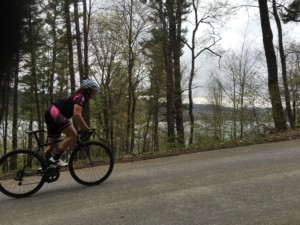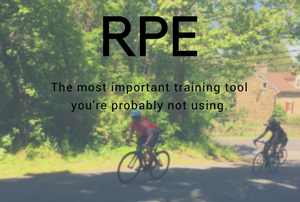You've no doubt heard about an RPE scale in the past. You may have even done some of your training by RPE. But in a world where power meters, heart rate monitors, and analysis software rules, is there any room for this subjective measurement?
I'd honestly argue that it's more important now than ever.
In a sport that has become increasingly dependent upon technology, cyclists are losing that “feel” that separates the good from the great. The best and most successful cyclists are able to instantly tell you how hard they are working. It doesn't matter if they're at tempo pace or flat out VO2 max level efforts. They know. And knowing is the key to performing.
Click on the jump to find out what RPE is and how it can benefit your training.
What is an RPE scale
The RPE scale, or Rating of Perceived Exertion scale, was developed by Swedish physiologist Gunnar Borg in the mid-1970s. He wanted to find a way to quantify the intensity of a physiological response without using objective data collecting equipment (like a power meter or a [easyazon_link identifier=”B00INQVYZ8″ locale=”US” tag=”taicoaandthed-20″]heart rate monitor[/easyazon_link].) Thus, he developed this subjective, relative measurement of intensity based on how a subject feels during activity.
The nice thing about an RPE scale is that it's completely personal to you. Since it's a subjective measurement of how you feel, it scales with your fitness and is individual to you and you alone. For example, your 300 watts may feel relatively sustainable while the guy next to you is struggling with the same 300-watt effort. Similar numerical outputs don't mean you're working at the same intensity.
Now, that may seem a little bit odd to hear. I've always been a proponent that wattage is wattage, and that is still true. However, that's only true when you're comparing yourself to yourself. Hence, you can see the value of an RPE scale.
What does an RPE scale look like?

For a good example of an RPE scale, take a look at the image to the right. This is the scale that I recommend using with my training systems. There are plenty of other versions of the RPE scale that more closely resemble the original Borg scale. The problem with those 20 point scales is that I find people have a hard time settling on a single number during an effort.
When presented with 14 different options, it's much harder to settle on a single number. Comparatively, the six categories of the RPE chart that I use cuts down on the choices and prompts you to make a quick decision on where your intensity is.
How does RPE benefit your training?
In a world of objective scientific data, how can RPE training benefit your cycling? Well, there are a few ways you can use RPE to improve your training outcomes.
What does XXXX intensity feel like?
Learning what different intensities feel like can be a valuable tool in the heat of the moment. In most cases, when the pace gets ratcheted up, you don't have the luxury of staring at your computer screen. In fact, just the simple act of glancing at your computer in the middle of a tight peloton can be a recipe for disaster.
Imagine you look down on your computer, trying to get a bearing on your intensity. Something happens in the pack in front of you and you're not watching to react. Suddenly you're on the ground, maybe with some other people. And it happened because you were looking somewhere you didn't need to be.
By doing intervals at an intensity you think is correct, then going back and seeing if you were right, you learn to get a feel for a specific intensity. Over time, a good, attentive athlete can tell exactly how hard they are going at any given point in a ride.
Gauging your efforts without your computer
In addition to being able to tell how hard you're going without looking down, it's important to gauge your efforts if you don't have any technology. If your Garmin dies, you forget it, or another piece of equipment (such as a power meter) fails, you need to be able to quantify your effort, even if only subjectively.

In some cases, being able to gauge your effort accordingly may mean the difference between success and failure. From personal experience, when my power meter died prior to the Tour of the Battenkill, it cost me. I spent so much time training to the numbers that I had forgotten to check down on my RPE during the race. Without the numbers, I was flying blind. Not only did I end up pushing well beyond the brink, it actually ended my race (with back spasms.) Had I been a little more cautious, I should have been able to tell that I was going way too hard and backed down, preserving something to keep me in the race.
Oh well, live and learn.
With those reasons in mind, how do you actually go about doing some RPE training?
How do you perform RPE training?
RPE sounds easy, but it takes a while to get used to. However, I've found there is a pretty simple process you can follow that will help get you training with RPE in no time.
For the sake of argument, let's assume that we're going to do a series of VO2 max intervals. The workout will be 6 sets of 3 minutes of work at 120% of FTP. Get a good warmup then follow these steps:
- Complete the first 3-minute interval while watching your computer AND keeping an eye on how your body feels. Focus specifically on how hard that effort feels and key in on that feeling. This process gets the relative RPE for the day set.
- Do the next interval while only periodically checking your computer. For example, you may check during the first 15 seconds and last 15 seconds. Keep a note of the RPE.
- Do the rest of your intervals at the RPE you think you should be at. Remember, it should feel like the first interval of the day, maybe a touch harder depending on how fatigued you are. Record your data on your computer.
- After the interval session is completed, write down (or somehow record) the RPE you felt during each interval. Upload your device data and look at the average wattages of those intervals. If you're around the target wattage, your RPE calculation was on point. If you're off, look at how far and adjust next time.
By repeating intervals you learn more about what each intensity feels like and you'll be more able to precisely dial in your intensity each time.

When to use RPE?
Now that you have a concept of RPE and how to use it, the million dollar question is when do you use it? It may seem like a silly question, but at what point should you ignore your computer and switch to RPE (or visa versa?) Should you train exclusively with RPE during training? Will you rely on it during races only?
The simple answer is: always train with RPE. Make it a common component in your training logs and learn what those activities feel like. Should you replace your power based metrics with RPE? Probably not, but at least combine the two of them so you can have an additional dimension to compare your objective data to.
In the case of a competitive situation, you'll likely rely on RPE a little more than during training. During competitive riding, you won't have as much time to look at a computer and figure out how long and hard you've been riding. RPE is ultimately a quick “gut check” to see how hard you've been riding and how much you have left in the tank.
So if you're not doing RPE training, why not? Grab that RPE scale, put it on your handlebars next to your computer and start learning about your body!
